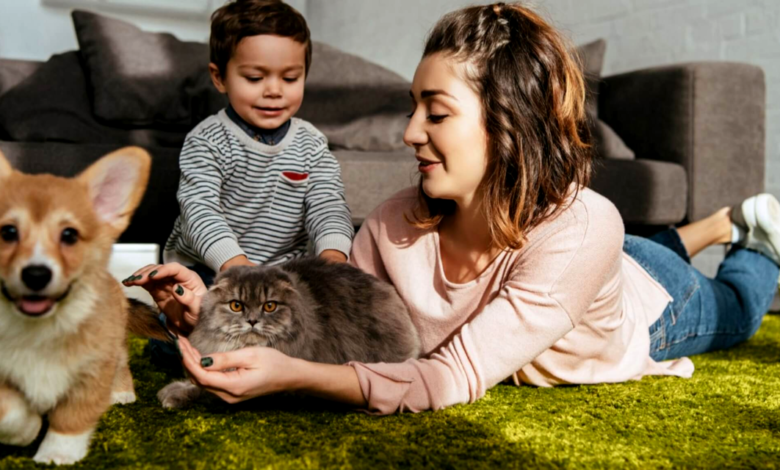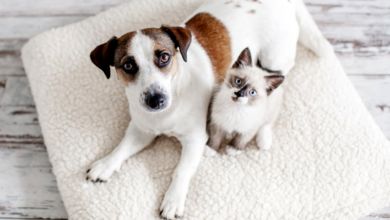
How to Introduce New Pet to Your Home
Introducing a new pet into your home is an exciting yet delicate process. Whether it’s a playful puppy, a curious kitten, or any other type of animal companion, proper introduction is crucial for fostering positive relationships and ensuring harmony among your furry family members. In this comprehensive guide, we’ll explore step-by-step strategies to help you introduce a new pet to your home with confidence and ease.
Read More: Smart Home for Pets: A Pet Owner’s Guide to Home Automation
Preparing Your Home

Before bringing your new pet home, it’s essential to create a safe and welcoming environment for them. Start by designating a specific area where your new pet can feel secure, such as a cozy corner or a separate room equipped with bedding, food, and water bowls, litter boxes (if applicable), and plenty of toys to keep them entertained. Remove any potential hazards or dangerous objects from the environment, such as toxic plants, small objects that could be swallowed, or electrical cords that could pose a risk of injury.
Understanding Your New Pet
Each type of pet has its own unique behaviors, instincts, and needs, so take the time to research and familiarize yourself with your new companion’s species-specific traits. Consider factors such as their temperament, activity level, dietary requirements, grooming needs, and any medical conditions they may have. Understanding your pet’s individual characteristics will help you tailor the introduction process to their specific needs and ensure a smoother transition into your home.
Introduction Techniques
When introducing your new pet to your existing pets, it’s essential to proceed slowly and gradually to minimize stress and prevent conflicts. Start by allowing your pets to become familiar with each other’s scents by exchanging bedding, blankets, or toys before their initial meeting. This will help them associate each other’s scent with positive experiences and reduce the likelihood of aggression or territorial behavior during their first encounter.
Introducing Pets
The method of introducing pets to each other may vary depending on their species, personalities, and individual preferences. When introducing dogs to other dogs, consider starting with a neutral territory, such as a nearby park or a quiet street, where they can meet on a leash and explore each other’s presence in a controlled environment. Allow them to approach each other gradually and observe their body language for signs of friendliness, curiosity, or tension.
Introducing cats to other cats may require a more gradual and cautious approach, as felines are known for their independent nature and territorial instincts. Provide separate spaces for your new cat and resident cat initially, allowing them to smell and hear each other through a closed door before gradually introducing visual contact under supervised conditions. Use treats, toys, and positive reinforcement to create a relaxed and positive atmosphere during their interactions.
Signs of Successful Introductions
As your pets become accustomed to each other’s presence, observe their behavior for signs of successful integration. Positive indicators may include relaxed body language, such as wagging tails, and soft ears, and playful interactions, such as chasing, wrestling, or grooming each other. Additionally, watch for the sharing of resources, such as food bowls, water dishes, or sleeping areas, as this indicates a willingness to coexist peacefully and share their space with each other.
Managing Challenges
Despite your best efforts, conflicts may arise during the introduction process, especially if your pets have strong personalities or previous negative experiences with other animals. If aggression or hostility occurs, separate the animals immediately and avoid intervening directly to prevent injury to yourself or your pets. Seek professional guidance from a qualified veterinarian or animal behaviorist, who can offer personalized advice and practical strategies for managing challenging behaviors and fostering positive relationships between your pets.
Seeking Professional Help
If you encounter difficulties during the introduction process, don’t hesitate to seek professional assistance from a qualified veterinarian or animal behaviorist. They can assess the situation and provide tailored advice and support based on your pets’ individual needs and circumstances. Additionally, they can recommend training techniques or behavior modification strategies to address specific issues and help facilitate a smoother transition for your furry family members.
Monitoring Progress
Throughout the introduction process, it’s essential to monitor your pets’ progress closely and make adjustments as needed to ensure their safety and well-being. Be patient and understanding, as building trust and rapport between animals takes time, and setbacks are normal. Keep a journal or log of their interactions, noting any changes in behavior or mood, and consult with your veterinarian or animal behaviorist regularly to track their progress and address any concerns that may arise.
Building Bonds
Once your pets have become accustomed to each other’s presence and established a basic level of comfort and trust, focus on building positive associations and strengthening their bonds through shared experiences and activities. Spend quality time together engaging in interactive play, training sessions, or relaxing cuddle sessions to reinforce their sense of companionship and mutual respect.
Maintaining Harmony
To maintain harmony in a multi-pet household, establish clear routines and boundaries for all pets and consistently enforce them to prevent conflicts or misunderstandings. Provide each animal with individual attention and affection to prevent jealousy or resentment, and address any disputes or disagreements promptly and calmly to prevent escalation. With patience, consistency, and a proactive approach to communication and conflict resolution, you can help foster harmonious relationships between your furry family members and create a happy and harmonious home for all.
Read More: How to Create a Pet-Friendly Home Environment
FAQs
- How long does it take for pets to adjust to each other? The adjustment period varies depending on the personalities and species of the pets involved. Some pets may become fast friends, while others may require several weeks or even months to acclimate to each other.
- What should I do if my pets fight during introductions? If your pets engage in aggressive behavior during introductions, separate them immediately and consult with a professional veterinarian or animal behaviorist for guidance. Avoid intervening directly in physical altercations to prevent injury to yourself or your pets.
- Can I introduce multiple pets at once? It’s generally recommended to introduce pets one at a time to minimize stress and prevent overwhelming existing pets. However, if you have multiple new pets, introduce them gradually and individually to each existing pet to facilitate smoother transitions.
- How can I prevent jealousy between my pets? To prevent jealousy between pets, ensure each animal receives individual attention, affection, and rewards. Establish fair and consistent rules and routines for all pets, and avoid showing favoritism to prevent feelings of resentment or rivalry.
- What should I do if my pets don’t get along? If your pets continue to exhibit hostility or aggression towards each other despite your efforts, seek professional help from a veterinarian or animal behaviorist. They can assess the situation and provide personalized advice and strategies for managing conflicts and improving relationships between your pets.
The Final Words
Introducing a new pet to your home can be a rewarding yet challenging experience, but with proper preparation, patience, and understanding, you can help ensure a smooth transition and foster positive relationships between your furry family members. By following the step-by-step strategies outlined in this guide and seeking professional assistance when needed, you can create a safe, loving, and harmonious environment where all your pets can thrive and flourish together.







